|
Australia > Long Distance Australian Train Journeys > Australian Rail Photography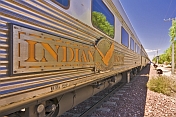
Taking Good Photographs on Australia's Long-Distance Trains
A guide for backpacker and budget travellers
Introduction
As you would expect on the website of a travel photographer, I thought it important to have a page that is all about photography on the Long Distance Trains of Australia: the 'Indian Pacific', the 'Ghan', and the 'Overland'. It tells you what to expect if you hope to take good photographs during your journey in one of the Red Class carriages, where the likely locations of your best shots will be, and what you can do to improve how your images turn out.
Lets start with photographs of the scenery that you encounter as you move through the Australian countryside, and here I need to be quite frank: photography from the Long Distance Trains of Australia trains can be problematic. Why? Because there are no opening windows in the passenger-areas of the train - there's just one window that opens in the guards van, but you won't be allowed in there whilst the train is moving. The train doesn't stop very often apart from at the major stations enroute, (more about those below) and even when it does make a request stop at one of the small stations along the way, the exterior carriage doors are only un-locked if you happen to be getting off there.
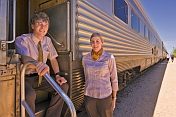 So, with the possibility of off-train photography (apart from at major stations) ruled out, the only alternative for anyone hoping for photographs along the way must be to take them through the carriage windows. Here we run into another problem: the windows next to the 'Day-Nighter' seats in Red Class are double thickness, with a venetian blind between two panes of glass. This blind can be raised or lowered with a small metal handle situated above the window. Unfortunately for photographers, the gap between the inner and outer sheets of glass cannot be easily accessed, and hence is rarely if ever cleaned. Most of the windows in my carriage, and all the other Red Class carriages that I saw, had long streaks of evaporated condensate or a white film of accumulated particulates on both interior surfaces, and the glass surfaces were clean only where the blinds had rubbed against the glass, forming a small vertical channel of clean glass some two inches wide that only helped to illustrate just how dirty the rest of the glass was. This dirt on the glass makes the taking of reasonable quality photographs through these windows impossible. So, with the possibility of off-train photography (apart from at major stations) ruled out, the only alternative for anyone hoping for photographs along the way must be to take them through the carriage windows. Here we run into another problem: the windows next to the 'Day-Nighter' seats in Red Class are double thickness, with a venetian blind between two panes of glass. This blind can be raised or lowered with a small metal handle situated above the window. Unfortunately for photographers, the gap between the inner and outer sheets of glass cannot be easily accessed, and hence is rarely if ever cleaned. Most of the windows in my carriage, and all the other Red Class carriages that I saw, had long streaks of evaporated condensate or a white film of accumulated particulates on both interior surfaces, and the glass surfaces were clean only where the blinds had rubbed against the glass, forming a small vertical channel of clean glass some two inches wide that only helped to illustrate just how dirty the rest of the glass was. This dirt on the glass makes the taking of reasonable quality photographs through these windows impossible.
The windows in the 'Matilda Cafe' (the name for the Red Class buffet car) are of a similar design, but in this case the inner pane of glass is hinged and can be opened quite easily. These windows were all much cleaner and photography was possible, though still with the disadvantage of being through 2 thicknesses of glass, with its attendant problems of distortion and multiple reflections, making the taking of reasonable quality photographs through these windows almost as difficult.
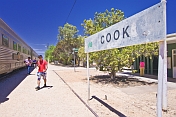 The third, and in my opinion the only alternative for images of the scenery you are passing through, is to take your photographs through the door windows in the foyer of each carriage. These are only a single thickness of glass, and are kept quite clean. There are no seats in the foyers, though, so you must stand whilst waiting for that next perfect shot of Nullabor wildlife or salt-scrub bushes. At sunset there are usually quite a number of other photographers wishing to shoot through these windows, so if you are especially interested in sunsets I would advise you to take the best position quite early. Keep the end of your lens tight against the glass to stop unwanted reflections or images of the overhead courtesy lights. The third, and in my opinion the only alternative for images of the scenery you are passing through, is to take your photographs through the door windows in the foyer of each carriage. These are only a single thickness of glass, and are kept quite clean. There are no seats in the foyers, though, so you must stand whilst waiting for that next perfect shot of Nullabor wildlife or salt-scrub bushes. At sunset there are usually quite a number of other photographers wishing to shoot through these windows, so if you are especially interested in sunsets I would advise you to take the best position quite early. Keep the end of your lens tight against the glass to stop unwanted reflections or images of the overhead courtesy lights.
Taking Photographs Through Glass - Some Tips
When it comes to taking photographs through glass, there are a few vital tips that will help you get the best image. The first thing to concentrate on is the availability of a spotlessly clean area of glass. Although the train staff do a good job keeping these windows clean, there will always be someone else who leans their head against the glass, or touches the surface with their hands, and leaves greasy smears behind. I'd suggest carrying your own cloth to remove these latest finger marks. A small bottle of window cleaner might also be useful. When the door is opened at one of the major stops, remember to clean the outside of the window too.
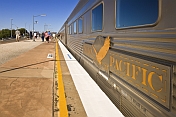 Next, we need to deal with unwanted reflections. Any person or object that is lighter than the scene outside the window will cause a reflection on the inside surface of the glass that will ruin your photo, and unless you are a very experienced photographer, its easy to overlook these reflections when concentrating on the distant scene itself at the vital moment. Also, there is a small light above the foyer windows that can't be turned off by a passenger, so its white reflection will clearly show on the glass in the same way, and ruin your shot. You could try using a Polarising Filter to reduce reflections, but the best way to eliminate them completely is to hold the front of your lens tight against the glass surface of the window. This does have the disadvantage that your view is restricted to one taken at ninety degrees to the route of the carriage, but will still allow you to take some very good shots. If you wish fo more freedom when shooting through glass, you could use a cone or hood of black material with its point surrounding your lens, and its edges held against the glass, but this is a rather extreme solution, and would probably require assistance to hold the material against the glass whilst you manipulated the camera. Next, we need to deal with unwanted reflections. Any person or object that is lighter than the scene outside the window will cause a reflection on the inside surface of the glass that will ruin your photo, and unless you are a very experienced photographer, its easy to overlook these reflections when concentrating on the distant scene itself at the vital moment. Also, there is a small light above the foyer windows that can't be turned off by a passenger, so its white reflection will clearly show on the glass in the same way, and ruin your shot. You could try using a Polarising Filter to reduce reflections, but the best way to eliminate them completely is to hold the front of your lens tight against the glass surface of the window. This does have the disadvantage that your view is restricted to one taken at ninety degrees to the route of the carriage, but will still allow you to take some very good shots. If you wish fo more freedom when shooting through glass, you could use a cone or hood of black material with its point surrounding your lens, and its edges held against the glass, but this is a rather extreme solution, and would probably require assistance to hold the material against the glass whilst you manipulated the camera.
Taking Photographs From A Moving Train - Some Tips
So, with the problems of glass dealt with, are there any other tips for taking a good photograph from a moving train? To start with, don't photograph straight into the sun if you can avoid it. Better to choose the side of the train facing away from the sun. Next, choose a suitable shutter speed to let you freeze the moving image - here we are talking about 500th/second or higher. Blur will always ruin a shot, unless chosen on purpose for a special effect, and can't be corrected later in PhotoShop. It is better to choose a slightly higher film speed (ISO) to maintain a suitable shutter speed, even at the risk of some graininess. This graininess can often be dealt with later using a suitable Noise Reduction program, but blur can not. Try not to include too much of the foreground in the shot, as this area of the frame will blur more easily than the middle ground or the distant view. To start with, don't photograph straight into the sun if you can avoid it. Better to choose the side of the train facing away from the sun. Next, choose a suitable shutter speed to let you freeze the moving image - here we are talking about 500th/second or higher. Blur will always ruin a shot, unless chosen on purpose for a special effect, and can't be corrected later in PhotoShop. It is better to choose a slightly higher film speed (ISO) to maintain a suitable shutter speed, even at the risk of some graininess. This graininess can often be dealt with later using a suitable Noise Reduction program, but blur can not. Try not to include too much of the foreground in the shot, as this area of the frame will blur more easily than the middle ground or the distant view.
Although the scene is rapidly changing, and so the chance for the photographer to appraise the shot diminishes, the importance of good composition at ALL times must still be emphasised. What appears to be a good photo in the heat of the moment must still be well composed if it is to be judged 'a Keeper' on later examination. Be ready for a tree or other foreground object that can be positioned to one side of the frame to give the image depth and balance. The scene changes very fast, and the position of items within the frame also changes rapidly, so the photographer needs to keep attention focused at all times, and be ready to react very quickly when a likely shot approaches. My best tip is to set your camera to 'burst-mode', where the camera takes a series of shots for as long as the shutter release-button is depressed. Most modern digital camera will allow you to take 6 frames per second, and some will go as high as 10 or 12. Press the shutter release-button a second before your visualised shot is ready, and hold it down until the scene has definitely passed by. By doing this, you will capture a series of images that show the shot from different angles and show the different elements within the shot at different positions in the scene. DON'T delete any straight away - wait until you have the chance to see the images on a suitable sized monitor before discarding any.
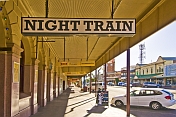 Taking Photographs at Major Station Stops Taking Photographs at Major Station Stops
Because of the 'through glass' and 'speed-blur' problems mentioned above, your best photographs will be those taken outside of the train, at one of the major stops along the way. If you are travelling on the 'Indian Pacific', this means Sydney, Broken Hill, Adelaide, Cook, or Perth. Although a stop is made at Kalgoorlie, it is likely to be too late in the day for any useful photographs, though exciting night shots at the mine are the main if not only reason that passengers go on the Whistlestop Tour there. Cook is quite a short stop but one of the most productive as far as the photographer is concerned, so you will need to be in a bit of a rush if you want to get many shots of the station, carriages and locomotive. Be prepared and make the effort, though, and these will probably be the best of your trip. Cook's remote location and small size means you can get some shots of the 'Australian Outback' with just a short walk past the abandoned bungalows. Keep your eyes open and you may see some dingos wandering about, too. You will also have a chance for some good shots of the locomotive during your stop at Cook. At the bigger stations, access to the locomotive may be cordoned off by barriers. In both Broken Hill and Adelaide you will have a good opportunity to take photos of the train and carriages. In Broken Hill it is quite easy to walk to the center of town for some interesting shots of the main street, court house, war memorial etc., but in Adelaide the station used is some 2km from the centre of town - see my Stations page for futher details.
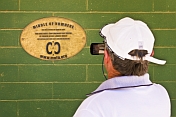 If you are travelling on the 'Ghan', the major stops, and therefore your only chance for off-train photography, are at Adelaide, Alice Springs, Katherine and Darwin. At Adelaide, the train will stop at the Parklands Terminal, which doesn't have a particularly inspiring backdrop, though should be good for some closeups of the carriages if the sun is in the right direction. Access to the locomotive may be restricted by barriers. At Darwin, there isn't much time available for photography. If arriving there, you will need to collect your bags and then go straight away to find the bus that is to take you into the city centre some 18km away. There is only one bus, so you can't afford to miss it! If leaving from Darwin, there isn't much time between when the bus arrives at the Berrimah Road terminal and when the train departs. Also, the staff prefer all passengers to be seated straight away, rather than wandering along the platform, so your chance to take photos may be limited here. See my Stations page for futher details. This leaves Alice Springs and Katherine for your best off-train images. There are quite long stops at both of these stations, as plenty of time is allotted for the organised 'Whistlestop Tours'. In Alice Springs, the town is quite close and if you opt out of the organised tours there is time to walk east to the Central Business District (CBD) with its usual stores and the HQ of the Flying Doctor service, or south west to the Cultural Precinct and see the Natural History Museum, the Aviation Museum, the Historical Cemetery, and some interesting displays on Aborginal Culture. In Katherine, the railway station is 9km from town, and it is not possible to walk there and back in the time available. There is little to see surrounding the station, apart from some low and dense scrub woodland, so with little else to do, you will have plenty of time to photograph the locomotive and the carriages. If you are travelling on the 'Ghan', the major stops, and therefore your only chance for off-train photography, are at Adelaide, Alice Springs, Katherine and Darwin. At Adelaide, the train will stop at the Parklands Terminal, which doesn't have a particularly inspiring backdrop, though should be good for some closeups of the carriages if the sun is in the right direction. Access to the locomotive may be restricted by barriers. At Darwin, there isn't much time available for photography. If arriving there, you will need to collect your bags and then go straight away to find the bus that is to take you into the city centre some 18km away. There is only one bus, so you can't afford to miss it! If leaving from Darwin, there isn't much time between when the bus arrives at the Berrimah Road terminal and when the train departs. Also, the staff prefer all passengers to be seated straight away, rather than wandering along the platform, so your chance to take photos may be limited here. See my Stations page for futher details. This leaves Alice Springs and Katherine for your best off-train images. There are quite long stops at both of these stations, as plenty of time is allotted for the organised 'Whistlestop Tours'. In Alice Springs, the town is quite close and if you opt out of the organised tours there is time to walk east to the Central Business District (CBD) with its usual stores and the HQ of the Flying Doctor service, or south west to the Cultural Precinct and see the Natural History Museum, the Aviation Museum, the Historical Cemetery, and some interesting displays on Aborginal Culture. In Katherine, the railway station is 9km from town, and it is not possible to walk there and back in the time available. There is little to see surrounding the station, apart from some low and dense scrub woodland, so with little else to do, you will have plenty of time to photograph the locomotive and the carriages.
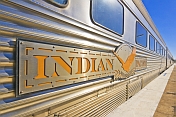 If you are travelling on the 'Overland', your main photo opportunities are limited to the starting and ending stations of Melbourne and Adelaide. Although the train does make stops along the way at North Shore Geelong, Ararat, Stawell, Horsham, Dimboola, Nhill, Bordertown, and Murray Bridge, the time that it waits at each of those stations is just a couple of minutes, and passengers not leaving the train at those points are not encouraged to get off. On my journey there was just one longer wait at Horsham station. Here the train was a little ahead of schedule, so we waited some five minutes at the station and many passengers stepped down to stretch their legs and stroll along the platform, but I was told by staff that this longer stop can not be relied upon. You will therefore need to take your train photographs at either Adelaide or Melbourne. The conditions and opportunities at Adelaide have already been mentioned above. At Melbourne, the 'Overland' departs and arrives at the Southern Cross station on Spencer Street, which is right in the heart of the city. The station is fully roofed so don't expect to get photos of the train in full sunlight. If you are travelling on the 'Overland', your main photo opportunities are limited to the starting and ending stations of Melbourne and Adelaide. Although the train does make stops along the way at North Shore Geelong, Ararat, Stawell, Horsham, Dimboola, Nhill, Bordertown, and Murray Bridge, the time that it waits at each of those stations is just a couple of minutes, and passengers not leaving the train at those points are not encouraged to get off. On my journey there was just one longer wait at Horsham station. Here the train was a little ahead of schedule, so we waited some five minutes at the station and many passengers stepped down to stretch their legs and stroll along the platform, but I was told by staff that this longer stop can not be relied upon. You will therefore need to take your train photographs at either Adelaide or Melbourne. The conditions and opportunities at Adelaide have already been mentioned above. At Melbourne, the 'Overland' departs and arrives at the Southern Cross station on Spencer Street, which is right in the heart of the city. The station is fully roofed so don't expect to get photos of the train in full sunlight.
Buy your rail pass here:
Still keen and want to find out more? Please visit the other pages in this article: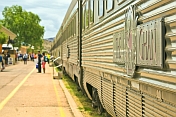
- Introduction
- Tickets And Passes - Where To Buy Them
- On Board The Train - Seating
- On Board The Train - Food
- On Board The Train - Facilities
- On Board The Train - Photography - THIS PAGE
- On Board The Train - Ghan And Overland Differences
- Packing List - Essential Items For The Journey
- Upgrading To Better Accomodation
- Whistlestop Tours
- Station Notes
- Great Southern Rail Train Photo Gallery
The photographs on these pages were all taken on my recent 32,000km journey around Australia. Click any image to see a larger version. The photographs are all available for licensing in a range of sizes - please Contact Me for details.
|
Tag Cloud
Popular searches on this site.
Latest Photos
View some of the latest images posted to GnomePlanet Travel Photography
Random Photo
Man and woman walk past Peggy\\'s Cove lighthouse tower..
|




